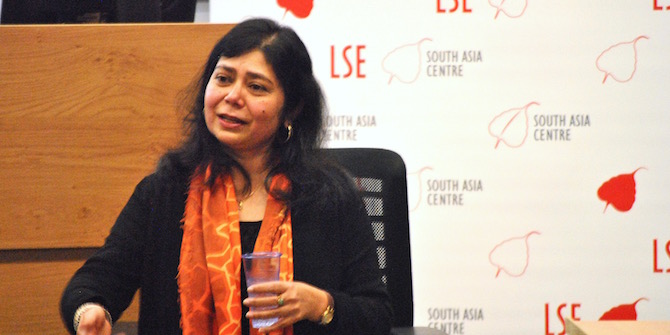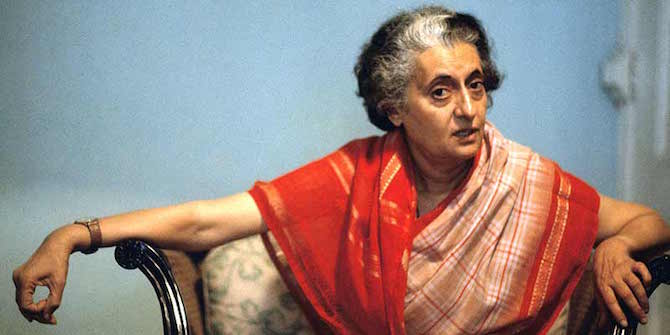Latika Chaudhary explores how colonial policies interacted with local conditions to influence the trajectory of Indian education. This is the second of two blogs on public goods provisions in colonial India.
The subject of education and human capital is among the most neglected in Indian economic history, even though recent decades have clearly established the importance of education to economic growth and development. An educated labour force has been linked to greater worker productivity, a faster ability to adopt new technologies and lower crime. Understanding the economics of India’s schooling record is important in and of itself, and also because it can inform debates surrounding the Indian economy under the Raj. This post uses quantitative data and examines specific factors that hurt the expansion of mass education in the late nineteenth and twentieth century in India.
Despite various political changes – including the decentralisation of education to provincial governments, and the transfer of education oversight to provincial legislative councils composed of elected Indian representatives – enrolment and literacy rates remained stable and disappointingly low for most of the colonial period. Total enrolment as a percentage of the population from 1850 to 1940 illustrates a picture of steady progress; that said, the increase is not particularly significant because India moved from an extremely low level of 0.014 per cent in 1853 to four per cent in 1940, which was still a low level.
The aggregate enrollment patterns provide strong evidence of India’s limited achievement at the primary level, but relatively superior performance at the secondary level. As late as 1891 only one out of 10 primary school-age children were enrolled in any type of school. The number of students enrolled steadily increased in the twentieth century, but even by 1941 only one-third of school age children (35 per cent) were enrolled in school, with sharp regional differences. Secondary and collegiate level enrolment was more remarkable—enrolment more than quadrupled between 1891 and 1941 with more than 6 per cent of school-age children attending secondary school by 1941.
However, these enrolment levels mask the tremendous regional heterogeneity within India. At every level, the more advanced coastal provinces of Bengal, Bombay and Madras out-performed the interior provinces of Bihar and United Provinces. Tremendous variation across social groups was also evident: Certain religions such as Christians and Jains were among the most literate in colonial India. At the other end of the spectrum, tribal groups living in geographically remote parts of the country had the lowest literacy, less than one per cent. Average Muslim literacy at 6.4 per cent was below Hindu literacy at 8.4 per cent, but there were significant regional differences. Among Hindus, there were large differences by caste—Brahmans at the upper end of the caste spectrum averaged 33 per cent, while depressed castes averaged 1.6 per cent.
Although the British created a new system of education, public investments in education were very small: Education accounted for a small share of the total budget averaging 3.5 per cent between 1881 and 1941. Official reports suggest British administrators were aware that spending was perhaps inadequate to meet the needs of expanding basic education, but they were also very critical of more spending leading to better outcomes. Official rhetoric often emphasised low demand as the primary constraint on educational development. This position may reflect colonial strategy to absolve the Indian government from any blame for the low level of investment. On the other hand, Congress leaders and Indian nationalists bemoaned the low public spending and advocated higher spending as the key to better outcomes.
Using a new district-level dataset on spending and literacy, I found that public investments on primary education had a positive and significant effect on male literacy. However, there were no similar effects on female literacy. Official British opinion and Indian opinion were thus both partially correct: higher public spending would have increased male literacy, but building more public schools was not the answer to the severe and persistent problem of female illiteracy. For any significant literacy gains across the population, the Indian government needed to substantially increase public spending on education.
By underinvesting in public education, colonial rule did constrain the development of primary education in India. But, this does not imply India would have enjoyed better outcomes as an independent state. If anything, the slow progress after 1947 underscores that inadequate funding was not the only problem. The presence of numerous castes and religions combined with the hierarchal divisions in Indian society seriously undermined private and public attempts to expand basic education.
Indian elites, defined by caste, wealth and occupation, were among the chief beneficiaries of English education. But, many of these same elites actively blocked schemes for public expansion of primary schooling. Landed elites were reluctant to support public education because they had to bear a disproportionate cost in terms of land taxes, the main source of local revenues for public primary schools. Educated elites belonging to the new urban intelligentsia were unlikely to promote mass education because it would increase competition for the much sought after Indian government jobs. Such resistance frequently occurred at different levels of government, either through the actions of local boards where landed and educated elites were disproportionately represented, or through direct lobbying of colonial officials.
The effects of caste and religious heterogeneity were even worse in the private sector because the government had limited control over private schools, even those that received public subsidies. Brahmans and other educated upper castes successfully directed private and, to a smaller extent, public resources to secondary schools for their children. Districts with a greater share of Brahmans had more public and private secondary schools plus a smaller ratio of primary to secondary schools. Districts with high levels of caste and religious diversity had fewer private primary schools and a smaller ratio of primary to secondary schools. However, upper castes were unable to completely co-opt the public policymaking process because districts with larger proportions of lower castes and Muslims also had more public secondary schools.
Official attempts to circumvent the local politics of school provision were not particularly effective at increasing literacy. In addition to caste problems, a heavy reliance on religious schools hurt the progress of Muslim literacy. Muslims in heavily Muslim-dominant districts had worse literacy because they had experienced a more recent collapse of Muslim political authority and hence had more powerful and better funded religious authorities. The religious authorities established religious schools, which were less effective at promoting literacy on the margin than public schools.
Colonial policies did not do much to ameliorate these long-standing inequalities between groups. Public spending was too low and susceptible to elite capture at many levels. Given the lack of emphasis on human capital development, it would appear that education was an important constraint on economic growth in colonial India.
For more information on this topic, see the working paper, “Caste, Colonialism and Schooling: Education in British India”.
Click here for a related blog on the economic role of railways in British India.
Latika Chaudhary is an Assistant Professor of Economics at Scripps College. She recently delivered the 2013 Epstein Lecture at LSE’s Department of Economic History.







you’ve come up with actually precise stats on the matter and that really is helpful. And yes, it was actually motivating to see more and more children getting admitted to schools with time.